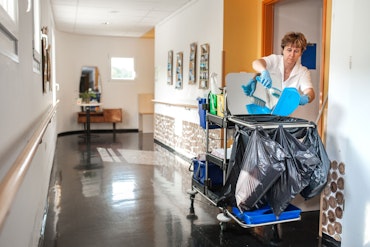Staff shortages in aged care have doubled in 12 months
The Committee for Economic Development of Australia (CEDA) has found that the aged care workforce crisis has doubled over the last year, with the worker shortfall increasing from 17,000 to 35,000.
![<p>The aged care sector is alarmed but unsurprised that workforce shortages have doubled over the last year in aged care. [Source: iStock]</p>](https://agedcareguide-assets.imgix.net/news/articles/news/articles/28_6_2022-Aged-care-shortages.jpg?fm=pjpg&format=auto&w=550&q=65)
The aged care sector is alarmed but unsurprised that workforce shortages have doubled over the last year in aged care. [Source: iStock]
A CEDA report released on Tuesday, Duty of care: Aged care sector in crisis, uncovered that poor Government action in the workforce and the challenges of the pandemic were the main drivers behind the shortage of workers.
It is estimated around 65,000 workers leave the aged care sector every year and 38 percent of aged care workers are intending to leave the sector within the next one to five years.
Senior Economist of CEDA, Cassandra Winzar, says if these workforce shortages continue there will not be enough staff available to meet the basic care standards that were recommended by the Royal Commission into Aged Care Quality and Safety.
“Miniscule levels of migration and increased levels of attrition in the sector, estimated to be around 65,000 workers a year, have exacerbated existing shortages,” explains Ms Winzar.
“The aged care workforce was already under significant pressure with staff shortages, low pay, poor working conditions and increased negative attention through the Royal Commission.
“Over the past year, COVID-19 has amplified these pressures. Aged care has been at the centre of many COVID-19 outbreaks, resulting in even more difficult working conditions and staff themselves becoming sick.
“For a workforce that was already burnt out prior to COVID-19, this has been the breaking point for many. During a time where unemployment is low, many have chosen to leave the sector.”
While the new Federal Government has committed to improving quality aged care through fast-tracking 24/7 Registered Nurses in aged care and introducing longer mandated care time, these promises will not be achievable with the current turnaround in workforce numbers.
Ms Winzar says that reaching the goal of an extra 35,000 workers in aged care would only provide older Australians with basic levels of care and that reaching international best practice standards would require a further increase of around 8,000 more workers.
This data builds on CEDA’s report from last year, which estimated that the sector would have a shortfall of 110,000 aged care workers, directly providing care, within a decade if appropriate action was not taken.
The latest CEDA report makes recommendations for improving the workforce in the short-term, including:
- Federal Government, unions and providers work together to increase Award wages in the sector through the Fair Work Commission’s work value case
- Personal care workers to be recruited directly through temporary or permanent skilled-migration lists or by introducing a new ‘essential skills’ visa
- Industry and Governments implement low-cost re-training options for those returning to the sector to boost skills and attract workers
To read the full report, head to the Committee for Economic Development of Australia (CEDA) website.
Alarm bells are ringing for sector
This report has already raised deep concerns and alarm in the sector with industry peak body Aged & Community Care Providers Association (ACCPA) calling for immediate action to fix the ongoing workforce crisis in aged care.
Interim Chief Executive Officer (CEO) of ACCPA, Paul Sadler, says while the figures are alarming they were not unexpected.
“We believe the shortage could be even worse. CEDA says an additional 8,000 workers are needed to meet the new mandated minimum minutes of care for each resident in care; we believe it could be closer to 20,000,” explains Mr Sadler.
“The new Federal Government will have difficulty achieving its aged care policy priorities of Registered Nurses in aged care homes 24/7 and minimum care minutes without immediate action.
“The pandemic has taken its toll on the aged care sector with thousands of staff leaving or planning to leave due to low pay, burnout or simply finding better job opportunities. The CEDA report highlights the need for urgent action to ensure older Australians do not miss out on care and support.
“Funding is a key issue. We welcome the Government’s commitment to fund a pay increase for aged care workers arising from the Fair Work Commission work value case due later this year or early next year.”
This week, ACCPA says it is expected that the Government will announce the indexation figures for 2022-23, which will give providers an idea of what subsidies payment increases they will receive to provide aged care over the next year.
The former Government had rejected a recommendation from the Royal Commission to raise the level of indexation of subsidises for providers, even though indexation for the Award wage and Superannuation Guarantee increased.
“Unfortunately, it’s possible there will be an even bigger gap this year between the increase in wage costs and indexation which has been inadequate over many years,” says Mr Sadler.
“The Royal Commission recommended the Government take short-term measures to address the funding shortfall until the recommended independent pricing authority of aged care services is established.”
Mr Sadler adds that ACCPA is working with the Government to find solutions and progress aged care reform, specifically around making aged care a more attractive career option.
Some of these solutions include:
- Higher pay to encourage casuals and part-time staff to take on more hours
- Ensure aged care facilities are better staffed
- Improving access to childcare for aged care workers
- Support the professional development of the personal carer role
- Improve training and staff development
- Greater skilled migration























